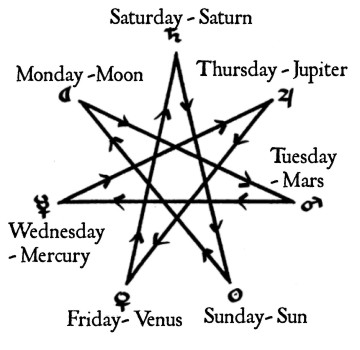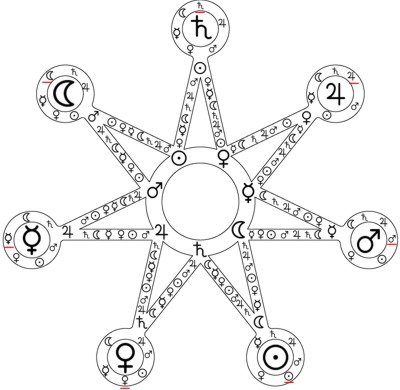Planetary Hours and Days (original) (raw)
The Planetary Hours and the Names and Sequence of the Days of the Week
As Lilly notes there are seven days of the week and seven planets and each planet rules or is lord of, one day: Sunday, the Sun; Monday, the Moon; Tuesday, Mars; Wednesday, Mercury; Thursday, Jupiter; Friday, Venus; and Saturday, Saturn. William Lilly, Christian Astrology, p. 482. The origin of the names of the days are explicitly planetary in medieval Latin: dies dominici (Sunday, the lord's day), die Lune, die Martis, die Mercuri, die Jovis, die Veneris, die Saturni.
In English the Teutonic equivalents of the Greek and Latin gods have been used for some of the names of the days, i.e. Tuesday is Tiw's day, the Teutonic god of war; Wednesday is Wotan's day; Thursday is Thor's day; Friday is Frigg's day. The 7 day week comes directly from astrology, the 7 days deriving from their lords, the 7 planets. We would note that from the introduction of the week in the classical period that the order has never varied or been interrupted. For example the adoption of the Gregorian calendar changed the date, but not the endless cycle of the days of the week.
As we can see the sequence and names of the days of the week are not in the Chaldean order, but nevertheless the sequence and names of the days of the week are closely connected to the Chaldean order. Two processes interact to produce the sequence of the days of the week: (1) the fact that the planetary hours follow the Chaldean order and; (2) the fact that the planet that rules the first hour of each day rules the whole day and gives the day its name.
Figure One is the standard diagram of the planets arranged in a circle in the Chaldean order. Starting with the Sun and then following the order of the days of the week and their planetary rulers, i.e. Moon, Mars, Mercury, Jupiter, Venus, Saturn, produces a seven pointed star, the heptagram of the week.
 Figure One - Heptagram of the Week
Figure One - Heptagram of the Week
Figure Two is an elaboration of the heptagram of the week adding the planetary hours. Note that there are seven large, bold planetary glyphs arranged in a large seven pointed star. These represent the planetary days, e.g., Sun rules Sunday, etc. The numerous small, unbolded glyphs represent the planetary hours and show their rulers.
Start with the Sun, the ruler of Sunday. Look for the large bold glyph of the Sun in the lower right hand corner of the diagram. Seven smaller glyphs are arranged around it in a circle. Look in the seven glyphs for the glyph of the Sun. The underlined glyphs indicate the first planetary hour of the day, in this case Sun hour, the first hour of Sunday. The next hour is represented by the glyph of Venus to the left of the underlined glyph of the Sun, thus the second hour of Sunday is ruled by Venus.
 Figure Two - Planetary Hour Heptagram
Figure Two - Planetary Hour Heptagram
So we follow the Chaldean order, from Venus (2nd hour of Sunday) to Mercury (3rd hour of Sunday) to the Moon (4th hour of Sunday), to Saturn (5th hour of Sunday), etc., etc, until we get to the medium size glyph of Saturn in the inner circle (12th hour of Sunday). Saturn is the ruler of the last hour of daylight on Sunday which ends with sunset.
Staying in the inner circle keep going up from Saturn to Jupiter (the 1st hour of Sunday night, beginning with sunset) up to Mars (2nd hour of Sunday night) and then leave the inner circle heading in a straight line to the large Moon glyph, keeping in the Chaldean order by going to the Sun (3rd hour of the night).
We then continue into the circle around the Moon glyph until we reach Mercury which is the ruler of the 12th hour of Sunday night and thus the ruler of the 24th hour of the whole planetary day of Sunday. Therefore we see that the next planetary ruler in the Chaldean order is the Moon, the ruler of the first hour of Monday. By following the diagram in the Chaldean order we can see the interaction of the planetary hours and the names and sequence of the days throughout the week.
Figure Two shows how the sequence of the planetary hours in the Chaldean order and the rulership of the planetary day by the first planetary hour ruler produces the order and names of the days of the week. Thus we can see that the order and names of the days of the week are not merely conventional, but part of an ancient natural and highly ordered astrological system.
This is just scratching the surface of an incredibly inherent order. For even more information on the Chaldean Order, the planetary days, hours, plus the planetary minutes and seconds, check out the Third Planetary Order page, which details my discovery of three basic ordering sequences based on the number 7, which are the Chaldean Order, the days of the week sequence, and the amazing Third Planetary Order!